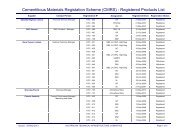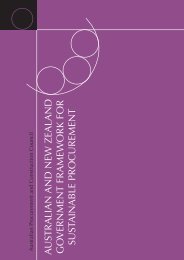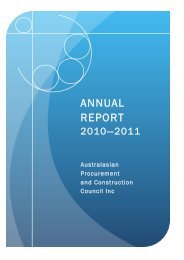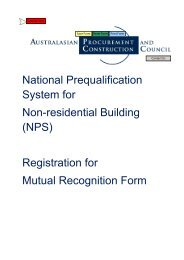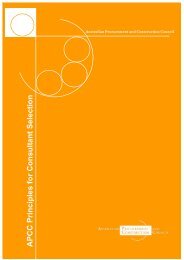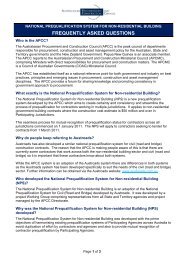ESD design guide for Australian Government buildings: Edition 2
ESD design guide for Australian Government buildings: Edition 2
ESD design guide for Australian Government buildings: Edition 2
You also want an ePaper? Increase the reach of your titles
YUMPU automatically turns print PDFs into web optimized ePapers that Google loves.
attachment two<br />
GBCA and Green Star accredited <strong>buildings</strong> 48<br />
The Green Building Council of<br />
Australia is a national, not-<strong>for</strong>-profit<br />
organisation that is supported by both<br />
industry and governments across<br />
the country. Launched in 2002, the<br />
Green Building Council’s mission is to<br />
promote sustainable development and<br />
drive the adoption of green building<br />
practices through market-based<br />
solutions.<br />
The Green Building Council<br />
aims to drive the transition of the<br />
<strong>Australian</strong> property industry towards<br />
sustainability by promoting green<br />
building programs, technologies,<br />
<strong>design</strong> practices and operations.<br />
Central to achieving these aims the<br />
Green Building Council launched<br />
the Green Star environmental rating<br />
system <strong>for</strong> <strong>buildings</strong> in 2003.<br />
GREEN STAR<br />
The Green Star environmental rating<br />
system recognises and rewards<br />
environmental leadership in the<br />
building industry. Green Star rating<br />
tools are being released <strong>for</strong> different<br />
phases of development (i.e. <strong>design</strong>,<br />
construction, procurement and<br />
operation) and all building types<br />
(office, retail, education, health,<br />
residential etc.). Green Star builds<br />
on exisitng environmental rating<br />
systems <strong>for</strong> <strong>buildings</strong>, including the<br />
UK’s ‘BREAAM’ (Building Research<br />
Establishment Environmental<br />
Assessment Methodology) and North<br />
America’s ‘LEED’(Leadership in<br />
Energy and Environmental Design) by<br />
establishing individual environmental<br />
measurement criteria relevant to the<br />
<strong>Australian</strong> marketplace and unique<br />
environmental context.<br />
Green Star rating tools use stars to<br />
measure per<strong>for</strong>mance. Projects that<br />
obtain a self-assessed 4 Star rating (or<br />
above) are eligible to apply <strong>for</strong> <strong>for</strong>mal<br />
certification. Green Star is Australia’s<br />
only comprehensive, industry-owned,<br />
national, voluntary environmental<br />
rating system <strong>for</strong> <strong>buildings</strong>.<br />
Green Star is the only rating system<br />
in Australia that evaluates the<br />
environmental impact of <strong>Australian</strong><br />
<strong>buildings</strong> at all phases of development<br />
and across all environmental<br />
categories, including:<br />
• Management<br />
• Indoor Environmental Quality<br />
• Energy<br />
• Transport<br />
• Water<br />
• Materials<br />
• Land Use and Ecology<br />
• Emissions<br />
INTERACTION WITH OTHER<br />
TOOLS<br />
Green Star was developed and<br />
funded by industry and government.<br />
Green Star’s framework brings<br />
existing tools and standards together<br />
under one unified system. Green Star<br />
rating tools are relevant to building<br />
type, phase of development cycle<br />
and geographical location. Green<br />
Star awards points <strong>for</strong> best practice<br />
initiatives and, as such, projects<br />
that receive a Green Star Certified<br />
Rating have demonstrated leadership<br />
and are considered to be in the top<br />
quartile of the market.<br />
Recognising the existence of other<br />
regulatory tools and to ensure<br />
project teams are not doubling up on<br />
their ef<strong>for</strong>ts, Green Star rating tools<br />
incorporate the <strong>Australian</strong> Building<br />
Greenhouse Rating (ABGR) scheme<br />
under the Energy Category. Green<br />
Star also addresses other energy<br />
efficiency initiatives such as onsite<br />
demand management, energy<br />
metering <strong>for</strong> base building and<br />
tenancies and more.<br />
GREEN STAR CERTIFICATION<br />
All Green Star rating tools recognise<br />
and reward initiatives that reduce the<br />
environmental impact of development.<br />
Points are awarded under eight<br />
environmental categories where a<br />
project demonstrates that initiatives<br />
have been met. A total score <strong>for</strong> each<br />
environmental category is calculated<br />
and a weighing is applied to this score<br />
that reflects the geographical location<br />
of the project and the enviornmental<br />
impact.<br />
Green Star rating tools use stars to<br />
measure per<strong>for</strong>mance. Projects that<br />
obtain a self-assessed 4 star rating (or<br />
above) are eligible to apply <strong>for</strong> <strong>for</strong>mal<br />
certification, whereby a:<br />
• 4 Star Green Star Certified Rating<br />
recognises and rewards “Best<br />
Practice”;<br />
• 5 Star Green Star Certified Rating<br />
recongises and rewards “<strong>Australian</strong><br />
Excellence”; and<br />
• 6 Star Green Star Certified Rating<br />
recognises and rewards “World<br />
Leadership”.<br />
GREEN STAR CERTIFIED<br />
BUILDINGS<br />
Council House 2 - 6 Star, Green Star<br />
- Office Design v1<br />
8 Brindabella Circuit - 5 Star, Green<br />
Star - Office Design v1<br />
40 Albert Road - 6 Star, Green Star<br />
- Office Design v1<br />
For updated in<strong>for</strong>mation see www.gbca.<br />
org<br />
48 Text <strong>for</strong> this page supplied by the Green Building<br />
Council.<br />
068<br />
<strong>ESD</strong> DESIGN GUIDE FOR AUSTRALIAN GOVERNMENT BUILDINGS


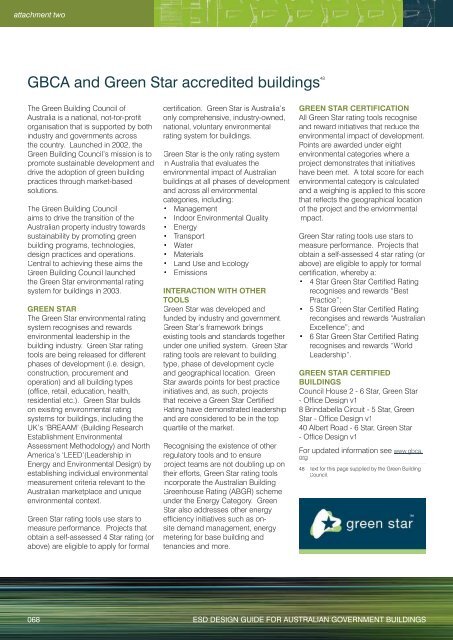
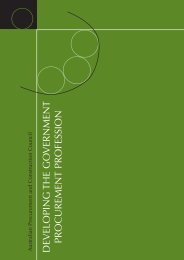
![NATIONAL COST ADJUSTMENT PROVISION EDITION 2 [NCAP2]](https://img.yumpu.com/48266135/1/184x260/national-cost-adjustment-provision-edition-2-ncap2.jpg?quality=85)

